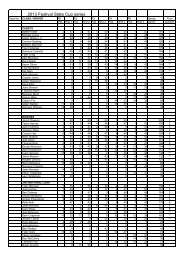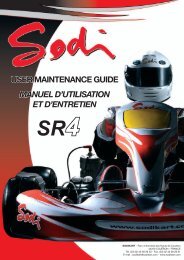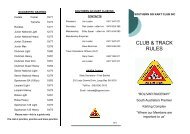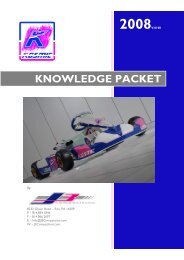Create successful ePaper yourself
Turn your PDF publications into a flip-book with our unique Google optimized e-Paper software.
Set-up tips1 - Basic Setting1-1 Seat Assembly (100 and 125ccm)1-2 Track and Camber Adjustment1-3 Tyre Pressure1-4 Which Accessories to begin with?2 - Dry Track2-1 Different Adjustments and their effects without changing theAccessories :• tyre pressure• tront and rear track• camber2-2 Mounted Parts and their effects• excentrics• stub axles• rear axles• wheel hubs• rims• stabilizors2-3 Systematic Checking- 1 -
Set-up tips1- Basic Setting1.1 Seat Assembly (100 and 125ccm)Heightdimension dimension dimensionA(mm) B(mm) C(mm)1m45 to 1m55 580 95 2201m55 to 1m70 590 90 2101m70 to 1m80 600 85 2001m80 to 1m90 610 85 1901.2 Front and Rear Track AdjustmentfrontWe use 35mm spacer rings with the 3-hole rims and the standardwheel hubs (70mm), which gives a total width of approx. 119cm(measured from the outer edge of the wheels).For the standard rims with bearings (without wheel hub) we usethe same amount of spacer rings and obtain a total width ofapprox. 116cm.- 2 -
Set-up tipsrearWe recommend a maximum width of 140cm for the Senior and136cm for the Junior category (measured from the outer edge ofthe wheels).1.3 Tyre Pressurefor soft tyres : 0,75 to 0,8 bar (warm)for medium tyres : 0,75 to 0,8 bar (warm)for hard tyres : 0,85 to 0,95 bar (warm)for wet tyres: front 1,0 to 1,6 bar and rear 1,2 to 1,8 bar(cold)The pressures indicated are for warm tyres, e.g. the pressuremust be measured immediately after the first laps, when thetyres are warm.Only wet tyres are measured in cold condition.1.4 Which Accessories to begin with?• front stabilizor• standard excentric (neutral)• standard rear wheel 90mm hubs• seat supports: 2 right and 2 left• standard stub axles n°2• standard rear axle (blue)• standard rims: Elektron Monostar- 3 -
Set-up tips2- For Dry Track Contitions2-1 Different Adjustments and their Effects without readjustingthe AccessoriesTyre PressureThe tyre pressure always depends on the track conditions, thetemperature, a.s.o., and variies from track to track.The tyre pressure changes once the tyres reach their optimumtemparature. The higher the pressure the faster the tyres’response time. It is very important however not to chose a toohigh pressure. The tyre reaches its « top efficiency » faster butalso wears down faster and the <strong>kart</strong> will start to skid.Generally said, the pressure should be lower the hotter it gets,and the colder it gets the more the tyres should be pumped.Front and Rear Track WidthThe rear width gives the chassis stability. For this reason weusually have 140cm for the Senior and 136cm for the Juniorcategory.The front track width has an effect on the whole chassisperformance in the curves. The wider the front track is the lessaggressiv the <strong>kart</strong> will be entering the curve, however the gripincreases at the end of the curve.On the other hand, when the width is smaller, the <strong>kart</strong> will bemore aggressive when entering less direct at the end of thecurve.The height adjustment of the track changes the position of the<strong>kart</strong>’s balance point and gives the chassis a certain stability.The lower the <strong>kart</strong> is at the front the more direct the chassis willbe, while losing, however, on efficiency after the angular point.The lower the chassis is at the rear the more steady it will be inthe curve.- 4 -
Set-up tips2-2 The Mounted Parts and their EffectsExcentricTh excentrics are small in sizebut most effective on the trackperformance. They balance thechassis, give grip in the frontwhen the <strong>kart</strong> is understeered ortake away grip when the <strong>kart</strong>sticks to the track. Theexcentrics are important <strong>kart</strong>components which must behandled with skill. The differentreactions they induce have aneffect on the castor angle.1. The more castor (using a « larger » excentric) the more grip inthe front. The <strong>kart</strong> has more bite but in the same time isharder to steer. Mount the excentric with the degree cypherpointing to the front to give the <strong>kart</strong> more grip.2. The smaller the castor angle the easier the <strong>kart</strong> can besteered, but the less grip you have in the front. The chassisbecomes more free on all 4 wheels. To take away grip theexcentric must be mounted the other way around (degreecypher upside down).The excentric without a cypher is 0° (neutral).The excentrics RR and RL are for rain : Rain Right and Rain Left.The cypher on the other excentrics indicates the degree withwhich you re-adjust the castor.- 5 -
Set-up tipsStub AxlesThe different stub axles change the chassis’ track performance onthe front axle in the whole curve.We apply stub axle no. 2 as a standard.Stub axle no. 1 makes steering easier – the chassis lessaggressive in the beginning and more direct in the middle of thecurve.Using stub axle no. 3 gives the chassis more bite in the beginningof the curve.Rear AxleThe blue rear axle (725) is our standard, medium hard axle.The red rear axle (726) is a little softer and is used when moregrip (rubber) is necessary on the track. This axle makes the thechassis run freely..length hardnessblue axle 725 105 cm hardred axle 726 105 cm softWheel HubsThe standard wheel hubs have a width of 70mm. There are alsoones with 90mm which give the <strong>kart</strong> more grip in the middle andthe end of the curve. These are often used on wet tracks.The standard rear wheel hubs have a length of 90mm and areimperatively recommended.The short wheel hubs (70mm) are mainly used on wet tracks.RimsMonostar rims (standard) give the chassis good grip.Mono-Racing rims are of magnesium. They take away grip and letthe chassis run freely. These rims are mainly used with soft tyresand good grip on the track.For wet tracks we recommend aluminium rims, front 120mm andrear 180mm.- 6 -
Set-up tipsStabilizorsAs the name says, the stabilizors give the chassis stability, bothfront and rear. When using the rear stabilizor it is important thatthe <strong>kart</strong> does not have too much grip, which would make theengine choke when accelerating.The front stabilizor is imparatively recommended.2-3 Systematic Checking• After driving, always check the tyre pressure• Before the first run, check if the seat is mounted properly.• After driving, always check if all screws are still tight (suitablywhen cleaning the <strong>kart</strong>).• Check the track and castor adjustments (see below).- 7 -
Set-up tips- 8 -
Set-up tipsAdjustment of the ParallismWork steps:• Take a spacer and then slide the track adjustment discs ontothe stub axles.• Straighten out the steering column.• Measure from the rear axle to the stub axle (as illustrated)and turn the track rods until the length is the same on bothsides.- 9 -
Set-up tipsTrack AdjustingWork steps:- Now measure the track adjusting discs on the front and backside of the disc from left to right (as illustrated).-> As a standard adjustment the track is open 2mm, i.e. thedistance from one disc to the other, measured in the front,must be 2mm larger than at the rear.- Turn the track rods until this distance can be measured.-> In order not to change the adjusted parallelism, the two trackrods must always be equally adjusted .-> For example when you measure 968mm at the back and972mm at the front, adjust 1mm on both sides of the trackrod.- When you have finished, check all measurements.- Now tighten the cone adapters.-> Make sure that the adjustment of the track rods remains thesame when you tighten the cone adapters. Block them whiletightening.-> After tightening, check if the ball joints rotate well.-> Re-check all measurements!- 10 -








